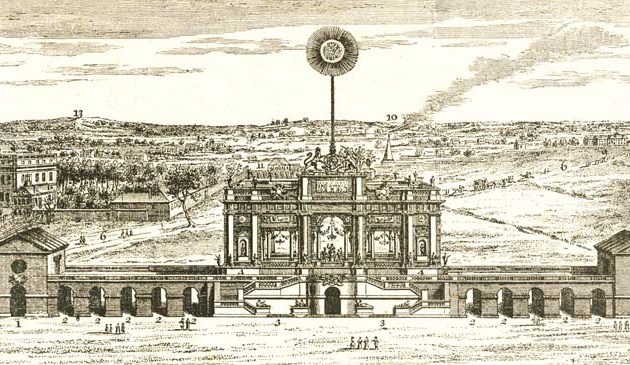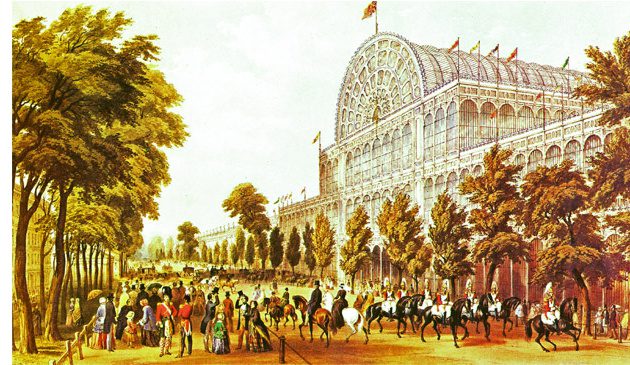Kensington Palace and Gardens

The West Front of Kensington Palace. It is separated from the adjacent street of Kensington Palace Gardens by Palace Green. Kensington Palace Gardens is now perhaps the most exclusive address in London, with houses selling for tens of millions of pounds. It was laid out in the 1840s over what was previously the kitchen gardens of the palace.
William Forsyth, a founder-member of the Royal Horticultural Society, was appointed gardener at Kensington in 1784. He made various changes, including planting fruit trees in the Upper Wilderness to the north of the palace. In the 1790s the gardens of were opened to “respectably dressed persons” from spring to autumn, sunrise to sunset, but soldiers, sailors, liveried servants, and dogs were excluded. Gate-keepers denied admittance to those not suitably dressed and the wrong sort of people. Unlike the adjacent Hyde Park, carriages were not admitted. A French visitor to London wrote in 1825: “At Kensington Gardens you are obliged to leave your carriage standing at the gate”.
A north-south carriage drive and the Serpentine Bridge over the lake were created by John Rennie in the 1820s, along the line of the boundary between Kensington Palace’s gardens and Hyde Park. It replaced the cascade that separated the Long Water and Serpentine. The ha-ha ended either side of the bridge. The width of the bridge straddled both Kensington Gardens and Hyde Park and thus railings were erected along its length to prevent intruders into the royal garden.
Princess Victoria, niece of the Prince Regent (later George IV) was born in Kensington Palace in 1819, unusually delivered by a female German doctor. (The same doctor also delivered her future husband, Albert). She was christened there by the Archbishop of Canterbury, with the name Alexandrina Victoria, her first name being derived from her godfather, the Emperor of Russia. Victoria spent her childhood at the palace, living in beautifully furnished apartments on the first and second floors. She had a fairly isolated upbringing during her early life, under the control of her strict mother and the equerry Sir John Conroy. As a young girl, however, she would ride around the gardens on her pet donkey, accompanied by her mother and older half-sister Princess Feodore, happily making conversation with any strangers she met. It was at the palace that Victoria first met her German cousin Albert, whom she was later to marry in 1840, when he visited with his father, Leopold, King of the Belgians.
At the time of her birth Victoria was fifth in line to the throne but all those above her predeceased King William and, upon his death in 1837, when she was 18 years old, Victoria was proclaimed as the new queen. She was given the news of her accession by the Lord Chamberlain and the Archbishop of Canterbury very early in the morning in her sitting-room of Kensington Palace. Several hours later she held her first Privy Council meeting of ministers in the palace’s Red Saloon. Conroy was quickly dismissed and her mother sent to live elsewhere in London.
The following month Victoria moved from Kensington Palace to Buckingham Palace. She wrote of her sadness at leaving her childhood home. From the early years of her reign the gardens of Kensington Palace were kept open to the public all year round. The ha-ha boundary that separated Kensington Palace Gardens from Hyde Park was gradually dispensed with during the 19th century and thus the two parks were effectively united. The ditch was infilled in 1868, although part of its route can still be traced today in the form of a slight depression across the grass. Walls that ran around the perimeter of the palace garden were replaced by railings to the design of Decimus Burton. The Mount was removed. A refreshment room opened in 1855, a bandstand in 1869, and drinking fountains and public lavatories added. From Victoria’s 80th birthday in 1899 the public were admitted to the newly-renovated State Rooms of the palace.
Following the tremendous success of the Great Exhibition in Hyde Park in 1851 Prince Albert proposed an area to the south of the park with permanent museums and a concert hall. Albert died in 1861 at the age of just 42 and did not live to see the fulfilment of his idea. Land was purchased for the concert hall and a memorial planned to the prince facing it in Kensington Gardens. Ideas were put forward for the memorial and the one by George Gilbert Scott was approved by Queen Victoria in 1863. The sculptor J.H. Foley was chosen to create the statue of the Prince within the memorial. Albert is surrounded by other statues representing Agriculture, Manufactures, Commerce and Engineering, and Europe, Asia, Africa and America. He holds the catalogue of the Great Exhibition of 1851. Work started on the 54-metre tall memorial in 1864 and took 12 years to complete at a total cost of £120,000. Up to 80 workmen were employed at any time and in later years it was discovered they had scratched caricatures into the backs of many of the heads. The concert hall opened in 1871 and was named the Royal Albert Hall.


